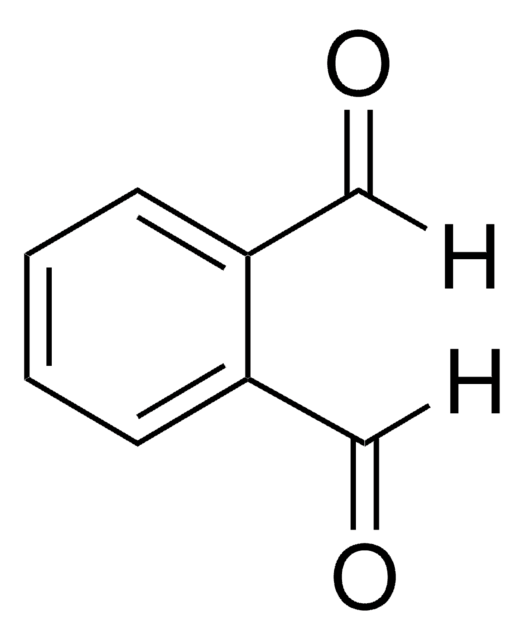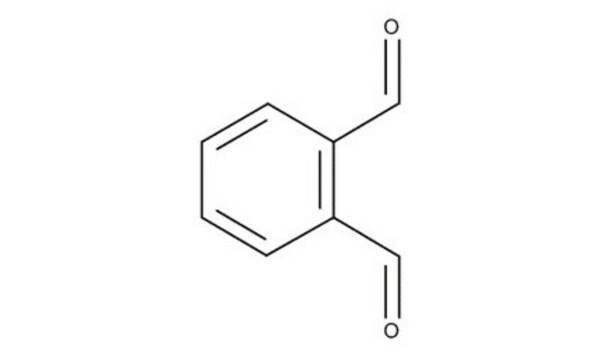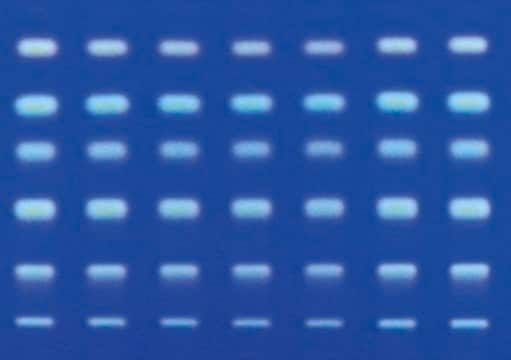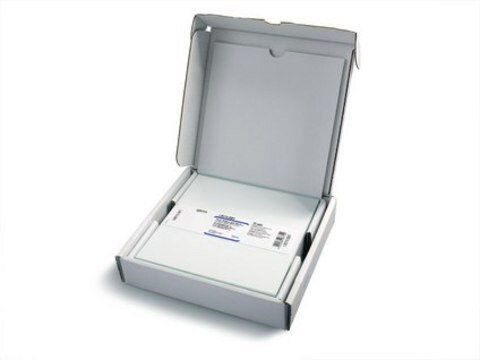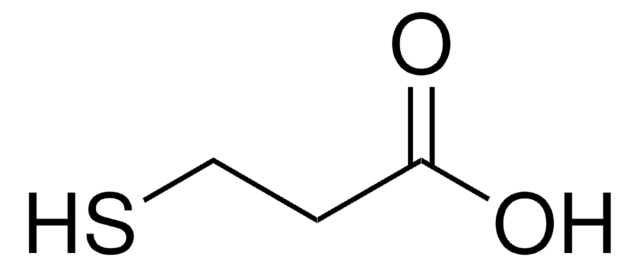1.11452
Phthaldialdehyde
for fluorometry
Synonyme(s) :
Phthaldialdehyde, OPA
About This Item
Produits recommandés
Niveau de qualité
Forme
solid
Température d'inflammation spontanée
480 °C
Puissance
178 mg/kg LD50, oral (Rat)
>2000 mg/kg LD50, skin (Rat)
pH
7 (20 °C, 53 g/L in H2O)
pb
83-84 °C/1 hPa
Pf
52-58 °C
Température de transition
flash point 132 °C
Solubilité
53 g/L
Densité
1.13 g/cm3 at 20 °C
Masse volumique apparente
530 kg/m3
Température de stockage
2-30°C
InChI
1S/C8H6O2/c9-5-7-3-1-2-4-8(7)6-10/h1-6H
Clé InChI
ZWLUXSQADUDCSB-UHFFFAOYSA-N
Application
- Combined techniques for revealing the mechanism beneath the inhibition effects of pectin on gluten digestibility using static in vitro gastro-duodenal protocols.: This study uses a combination of techniques to explore how pectin affects gluten digestibility, providing insights into the interaction of phthaldialdehyde derivatives with gluten proteins (Lin et al., 2024).
- Analysis of Gizzerosine in Foodstuffs by HPLC Involving Pre-column Derivatization with o-Phthaldialdehyde.: This research develops a method using HPLC with pre-column derivatization involving phthaldialdehyde to analyze gizzerosine in foodstuffs, demonstrating the compound′s utility in food safety studies (Li and Wu, 2024).
- Comprehensive studies on the development of HPLC-MS/MS and HPLC-FL based methods for routine determination of homocysteine thiolactone in human urine.: This study develops and validates methods using phthaldialdehyde derivatives for the determination of homocysteine thiolactone in human urine, contributing to clinical diagnostics and biochemical research (Piechocka and Głowacki, 2024).
- Smart-detection approach for protein residues to evaluate the cleaning efficacy of reusable medical devices.: Utilizing phthaldialdehyde for protein residue detection, this study provides a smart detection approach to improve the cleaning efficacy of medical devices, enhancing patient safety (Ouirungroj et al., 2024).
- One-pot sample preparation procedure for the determination of protein N-linked homocysteine by HPLC-FLD based method.: This research presents a novel one-pot sample preparation method using phthaldialdehyde for determining protein N-linked homocysteine, advancing analytical techniques in protein chemistry (Piechocka and Głowacki, 2023).
Remarque sur l'analyse
Identity (IR): conforms
Melting point: 54 - 58 °C
Fluorescence (340 nm, 0,8 g/l, ethanol, as quinine): ≤ 2 ppb
Phthalic acid (TLC): ≤ 0.5 %
Nitrogen compounds (as N): ≤ 0.05 %
Mention d'avertissement
Danger
Mentions de danger
Classification des risques
Acute Tox. 3 Oral - Aquatic Acute 1 - Aquatic Chronic 1 - Eye Dam. 1 - Skin Corr. 1B - Skin Sens. 1 - STOT SE 3
Organes cibles
Respiratory system
Code de la classe de stockage
6.1A - Combustible, acute toxic Cat. 1 and 2 / very toxic hazardous materials
Classe de danger pour l'eau (WGK)
WGK 3
Point d'éclair (°F)
269.6 °F - closed cup
Point d'éclair (°C)
132 °C - closed cup
Certificats d'analyse (COA)
Recherchez un Certificats d'analyse (COA) en saisissant le numéro de lot du produit. Les numéros de lot figurent sur l'étiquette du produit après les mots "Lot" ou "Batch".
Déjà en possession de ce produit ?
Retrouvez la documentation relative aux produits que vous avez récemment achetés dans la Bibliothèque de documents.
Les clients ont également consulté
Notre équipe de scientifiques dispose d'une expérience dans tous les secteurs de la recherche, notamment en sciences de la vie, science des matériaux, synthèse chimique, chromatographie, analyse et dans de nombreux autres domaines..
Contacter notre Service technique